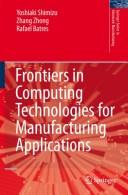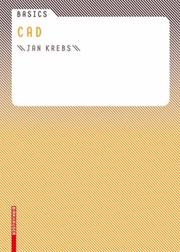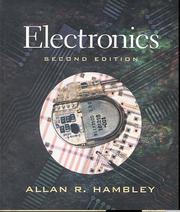| Listing 1 - 10 of 728 | << page >> |
Sort by
|
Periodical
Abstract | Keywords | Export | Availability | Bookmark
 Loading...
Loading...Choose an application
- Reference Manager
- EndNote
- RefWorks (Direct export to RefWorks)
Informatique --- Techniques d'imagerie --- computer assisted design --- Computer systems
Book
ISBN: 9781622573554 1622573552 9781622573462 1622573463 Year: 2012 Publisher: New York
Abstract | Keywords | Export | Availability | Bookmark
 Loading...
Loading...Choose an application
- Reference Manager
- EndNote
- RefWorks (Direct export to RefWorks)
Computer-aided design. --- CAD (Computer-aided design) --- Computer-assisted design --- Computer-aided engineering --- Design

ISBN: 1281066559 9786611066550 1846289556 1846289548 Year: 2007 Publisher: London : Springer,
Abstract | Keywords | Export | Availability | Bookmark
 Loading...
Loading...Choose an application
- Reference Manager
- EndNote
- RefWorks (Direct export to RefWorks)
In today’s competitive world, industries are focusing on shorter lead times, improved quality, reduced cost, increased profit, improved productivity and better customer service. As ERP and other information management systems have been widely implemented, information growth poses new challenges to decision makers in areas ranging from shop floor control to supply chain management and design. Frontiers in Computing Technologies for Manufacturing Applications presents an overview of the state-of-the-art intelligent computing in manufacturing. Modeling, data processing, algorithms and computational analysis of difficult problems found in advanced manufacturing are discussed. It is the first book to bring together combinatorial optimization, information systems and fault diagnosis and monitoring in a consistent manner. Techniques are presented in order to aid decision makers needing to consider multiple, conflicting objectives in their decision processes. In particular, the use of metaheuristic optimization techniques for multi-objective problems is discussed. Readers will learn about computational technologies that can improve the performance of manufacturing systems ranging from manufacturing equipment to supply chains. Frontiers in Computing Technologies for Manufacturing Applications will be of interest to students in industrial and mechanical engineering as well as information engineers needing practical examples for the successful integration of information in manufacturing applications. The book will also appeal to technical decision makers involved in production planning, logistics, supply chain, industrial ecology, manufacturing information systems, fault diagnosis and monitoring.
Production engineering --- Computer-aided design. --- Data processing. --- CAD (Computer-aided design) --- Computer-assisted design --- Computer-aided engineering --- Design
Book
ISBN: 128254215X 9786612542152 0080922007 0123743648 Year: 2009 Publisher: Amsterdam : Morgan Kaufmann/Elsevier,
Abstract | Keywords | Export | Availability | Bookmark
 Loading...
Loading...Choose an application
- Reference Manager
- EndNote
- RefWorks (Direct export to RefWorks)
This book provides broad and comprehensive coverage of the entire EDA flow. EDA/VLSI practitioners and researchers in need of fluency in an ""adjacent"" field will find this an invaluable reference to the basic EDA concepts, principles, data structures, algorithms, and architectures for the design, verification, and test of VLSI circuits. Anyone who needs to learn the concepts, principles, data structures, algorithms, and architectures of the EDA flow will benefit from this book.Covers complete spectrum of the EDA flow, from ESL design modeling to logic/test synthesis, verific
Electronic circuit design --- Computer-aided design. --- Data processing. --- CAD (Computer-aided design) --- Computer-assisted design --- Computer-aided engineering --- Design
Book
ISBN: 3034609353 9783034609357 Year: 2010 Publisher: Basel De Gruyter
Abstract | Keywords | Export | Availability | Bookmark
 Loading...
Loading...Choose an application
- Reference Manager
- EndNote
- RefWorks (Direct export to RefWorks)
Professor Ludger Hovestadt's Institute for Computer-Aided Architectural Design at the Eidgenössische Technische Hochschule (ETH) Zürich (Swiss Federal Institute of Technology, Zurich) is widely regarded as one of the world's most important institutes currently working at the interface between architecture and information technology. The combination of these two makes it possible to see architecture no longer as a separate sphere of technological reality but rather as one element of a society based on information technology. As a universal tool, the computer encourages one to think in terms of information structures and systems that span individual fields. This "rethinking" of the nature of architecture is leading to a paradigm shift at the methodological level of design, planning, construction, and economy. After a decade of experimentation, it has now become possible to see information technology for architecture as the basis for a new and energy-saving practical approach to building. This publication presents the work of the chair for CAAD using numerous examples - from the spectacular Monte Rosa Alpine hut of Andrea Deplazes to the residential development of KCAP. Professor Ludger Hovestadts Institut für Computer Aided Architectural Design an der ETH Zürich gilt als eines der weltweit wichtigsten Institute auf der Schnittstelle zwischen Architektur und Informationstechnologie. Diese Verbindung ermöglicht es, Architektur nicht mehr als einen getrennten Bereich der technischen Realität zu sehen, sondern als Bestandteil einer informationstechnologischen Gesellschaft. Der Computer als universales Werkzeug propagiert disziplinübergreifend ein Denken in Informationsstrukturen und -systemen. Dieses "neue Denken" von Architektur führt zu einem Paradigmenwechsel auf der methodischen Ebene von Entwurf und Planung, von Konstruktion und Ökonomie. Nach einem Jahrzehnt des Experimentierens ist es nun möglich, Informationstechnologie für die Architektur als Grundlage einer neuen, energiesparenden Baupraxis zu begreifen. Die Publikation stellt die entsprechende Arbeit des Lehrstuhls für CAAD anhand zahlreicher Beispiele vor - von der spektakulären Alphütte Monte Rosa von Andrea Deplazes bis zum Wohnbauprojekt von KCAP.
Architectural design --- Computer-aided design. --- CAD (Computer-aided design) --- Computer-assisted design --- Computer-aided engineering --- Design --- Data processing.

ISBN: 3035612749 3035612137 9783035612745 9783764381097 Year: 2017 Publisher: Basel
Abstract | Keywords | Export | Availability | Bookmark
 Loading...
Loading...Choose an application
- Reference Manager
- EndNote
- RefWorks (Direct export to RefWorks)
CAD beschäftigt sich mit der Umsetzung von Architekturzeichnungen mit dem Computer, der heute eine wesentliche Rolle in nahezu jedem Architekturbüro einnimmt. Dabei werden Grundlagen und Prinzipien des Computer Aided Designs erklärt, um dem Studienanfänger einen einfachen und verständlichen Zugang zum Medium und Werkzeug Computer zu ermöglichen.Themen: Der architektonische Entwurf im Dialog mit dem Computer Grundlagen im Umgang mit Soft- und Hardware Anwendungsorientierte Erläuterung der CAD-Funktionen Digitale Visualisierung Schnittstellen und Datenverarbeitung Computer aided design (CAD) is the rendering of architectural drawings using the computer, which today plays a central role in almost all architectural firms. This volume explains the principles and fundamentals of CAD and provides the student with a simple and easily understandable path to using the computer as a tool and medium.Subjects: The architectural design in dialogue with the computer; An introduction to working with software and hardware; Practical, user-oriented explanations of CAD functions; Digital visualization; Interfaces and data processing.
Computer-aided design. --- Engineering design --- Computer graphics --- CAD (Computer-aided design) --- Computer-assisted design --- Computer-aided engineering --- Design --- Computer programs.
Book
ISBN: 0191635855 1299453937 9780191635854 9781299453937 9780191748257 0191748250 9780199660353 0199660352 0191635863 Year: 2013 Publisher: Oxford : Oxford University Press,
Abstract | Keywords | Export | Availability | Bookmark
 Loading...
Loading...Choose an application
- Reference Manager
- EndNote
- RefWorks (Direct export to RefWorks)
Assessment is a key driver in mathematics education. This book examines computer aided assessment (CAA) of mathematics in which computer algebra systems (CAS) are used to establish the mathematical properties of expressions provided by students in response to questions. In order to automate such assessment, the relevant criteria must be encoded and, in articulating precisely the desired criteria, the teacher needs to think very carefully about the goals of the task. Hence CAA actsas a vehicle to examine assessment and mathematics education in detail and from a fresh perspective. One example is
Computer-aided design. --- Mathematics. --- Math --- Science --- CAD (Computer-aided design) --- Computer-assisted design --- Computer-aided engineering --- Design
Book
ISBN: 9783030906252 Year: 2022 Publisher: Cham Springer International Publishing :Imprint: Springer
Abstract | Keywords | Export | Availability | Bookmark
 Loading...
Loading...Choose an application
- Reference Manager
- EndNote
- RefWorks (Direct export to RefWorks)
Computer-aided design. --- Cognition. --- Architectural design --- Data processing. --- Psychology --- CAD (Computer-aided design) --- Computer-assisted design --- Computer-aided engineering --- Design

ISBN: 0582093864 Year: 1992 Publisher: Harlow Longman
Abstract | Keywords | Export | Availability | Bookmark
 Loading...
Loading...Choose an application
- Reference Manager
- EndNote
- RefWorks (Direct export to RefWorks)
Gestructureerd programmeren --- Programmation structuree --- Structured programming --- Architectural design --- Computer-aided design --- CAD (Computer-aided design) --- Computer-assisted design --- Computer-aided engineering --- Design --- Data processing --- Architecture --- Designs and plans

ISBN: 0136919820 9780136919827 Year: 2000 Publisher: Upper Saddle River Prentice Hall
Abstract | Keywords | Export | Availability | Bookmark
 Loading...
Loading...Choose an application
- Reference Manager
- EndNote
- RefWorks (Direct export to RefWorks)
| Listing 1 - 10 of 728 | << page >> |
Sort by
|

 Search
Search Feedback
Feedback About UniCat
About UniCat  Help
Help News
News